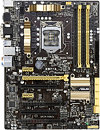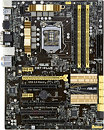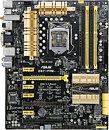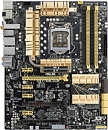Thursday, May 16th 2013

ASUS Announces its Mainline Z87 Classic Series, with a New Look
ASUS announced a fleet of socket LGA1150 motherboards, covering its mainline (classic), Republic of Gamers (ROG), and The Ultimate Force (TUF) lines. With this series, ASUS is adopting a new color scheme for its mainline motherboards, breaking away from the black PCB with blue heatsinks scheme it maintained since the first LGA1156 motherboards, almost four years ago. The new mainline motherboards from ASUS feature black PCBs with golden-colored heatsinks covering the VRM and PCH, and simpler naming. ASUS' first wave of Z87-based mainline (classic) motherboards include the entry-level Z87-C and Z87-A, mid-range Z87-PLUS and Z87-PRO, and premium Z87-DELUXE.The Z87-C covers the basics, including 4- phase CPU power, four DIMM slots supporting up to 64 GB of dual-channel DDR3 memory, a single PCI-Express 3.0 x16 slot wired to the CPU, a PCI-Express 2.0 x16 (electrical x4) wired to the PCH, two other PCI-Express x1 slots, and three legacy PCI slots. Display outputs include DVI, D-Sub, and HDMI. Storage connectivity includes eight SATA 6 Gb/s ports. 8-channel HD audio, four USB 3.0 ports, a single gigabit Ethernet connection, make for the rest of the board. This is the most affordable Z87-based motherboard from ASUS, and could occupy a sub-$100 price-point.
The Z87-A is a few notches above the Z87-C, with a stronger 8-phase CPU power, an expansion-slot loadout that includes two PCI-Express 3.0 x16 (electrical x16/NC or x8/x8), wired to the CPU, a third PCI-Express 2.0 x16 (electrical x4), wired to the PCH, and two each of PCI-Express x1 and legacy PCI; ten SATA 6 Gb/s ports, and other connectivity that includes 8-channel HD audio with optical SPDIF, gigabit Ethernet, and a few other ASUS-exclusives. The board supports 2-way SLI and CrossFireX, and should be the cheapest option for multi-GPU builds.
Moving on to the mid-range, we begin with the Z87-PLUS, which builds on the feature-set of the Z87-A. It features the same electrical system, while upping the ante with overclocker-friendly features, and connectivity. You find features that stabilize memory and CPU overclock at the push of a button, an obscene twelve SATA ports, the same expansion slot layout as the Z87-A, and the same connectivity options.
The Z87-PRO is designed for people who will opt for nothing less than the top socket LGA1150 processor. You get all ASUS-exclusive features of the Z87-PLUS, and 12-phase CPU power backed by EPU, two PCI-Express 3.0 x16 slots wired to the CPU (x16/NC or x8/x8), a PCI-Express 2.0 x16 (electrical x4, wired to the PCH), four PCI-Express x1 slots, eight internal and two external SATA ports, six USB 3.0 ports, 8-channel HD audio, gigabit Ethernet, WiFi (802.11 b/g/n), display outputs that include DVI, D-Sub, HDMI, and DisplayPort.
Leading the pack for ASUS' mainline Classic series, is the Z87-DELUXE. This board is probably the most connectivity-rich model in ASUS' entire portfolio of LGA1150 motherboards. It offers 16-phase CPU power, the same expansion-slot layout as the Z87-PRO, but drops in ten SATA 6 Gb/s ports, eight USB 3.0 ports, 802.11ac WiFi, dual gigabit Ethernet, and display outputs that include HDMI and/or DisplayPort. There are a few more overclocker-friendly features on offer.
The Z87-A is a few notches above the Z87-C, with a stronger 8-phase CPU power, an expansion-slot loadout that includes two PCI-Express 3.0 x16 (electrical x16/NC or x8/x8), wired to the CPU, a third PCI-Express 2.0 x16 (electrical x4), wired to the PCH, and two each of PCI-Express x1 and legacy PCI; ten SATA 6 Gb/s ports, and other connectivity that includes 8-channel HD audio with optical SPDIF, gigabit Ethernet, and a few other ASUS-exclusives. The board supports 2-way SLI and CrossFireX, and should be the cheapest option for multi-GPU builds.
Moving on to the mid-range, we begin with the Z87-PLUS, which builds on the feature-set of the Z87-A. It features the same electrical system, while upping the ante with overclocker-friendly features, and connectivity. You find features that stabilize memory and CPU overclock at the push of a button, an obscene twelve SATA ports, the same expansion slot layout as the Z87-A, and the same connectivity options.
The Z87-PRO is designed for people who will opt for nothing less than the top socket LGA1150 processor. You get all ASUS-exclusive features of the Z87-PLUS, and 12-phase CPU power backed by EPU, two PCI-Express 3.0 x16 slots wired to the CPU (x16/NC or x8/x8), a PCI-Express 2.0 x16 (electrical x4, wired to the PCH), four PCI-Express x1 slots, eight internal and two external SATA ports, six USB 3.0 ports, 8-channel HD audio, gigabit Ethernet, WiFi (802.11 b/g/n), display outputs that include DVI, D-Sub, HDMI, and DisplayPort.
Leading the pack for ASUS' mainline Classic series, is the Z87-DELUXE. This board is probably the most connectivity-rich model in ASUS' entire portfolio of LGA1150 motherboards. It offers 16-phase CPU power, the same expansion-slot layout as the Z87-PRO, but drops in ten SATA 6 Gb/s ports, eight USB 3.0 ports, 802.11ac WiFi, dual gigabit Ethernet, and display outputs that include HDMI and/or DisplayPort. There are a few more overclocker-friendly features on offer.





41 Comments on ASUS Announces its Mainline Z87 Classic Series, with a New Look
;)
:toast:
ASUS became AECS?
I don't mind the colours, its not like I will look the mobo all day long and my pc case is under the table ;)
Still, it would make sense to me to include one, as the Asus Deluxe and Premium variants almost always support more-than-2-way X-Fire/SLI (and I don't mean X8/X4/X4 because that's kinda pointless). I would expect them to at least offer x16/x16 or x16/x8/x8 or even x8/x8/x8 via PLX, and then reserve 4-Way with either full x16 or with 16x/x8/x16 3-way + x16/x8/x8/x8 4-way multi-GPU setups.
Power delivery looks good, especially on the higher-end "mainstream" boards. They seem to still be using the same VRM/Phase layout that they began en-mass with the Rampage IV Extreme, and as I know how well it works on that board with a CPU that's nearing the 300W mark, I imagine it'll work extremely well with CPU's that draw ~35-45% the power.
I do wish we would start seeing MORE phases for the RAM and PCI-Express, as currently we're pretty well set with CPU Phases (owning a GA-Z77X-UP7 with its 32-phase CPU VRM's that don't get more than warm to the touch even with all the switching frequencies cranked, and my 3770K @ 5.2Ghz with 1.3525v, ~1.2125v for VTT/VCCSA, as well as ~1.7425v vDIMM for 2x4GB G.Skill Trident-X 2400 9-11-11 @ 2740 10-12-10-31 1T, and an MSI G680 Lightning w unlocked voltages running 1438core/7568mem with +195 Power Percent, +84mV Core, +10mV VRAM, +10mV Aux Voltage).
The reason I say this is because with X79, for example, some of us are hesitant to run 8x DIMM's due to the negative effects it has on overclocking, while others have a difficult time overclocking their memory past 2133 or even 1866. I realize that a lot comes down to the chips' IMC, but it's practically a "rule" that Cleaner Voltage/Power Deliver = Less Total Voltage Required and Less Excess Heat due to more efficient regulation.
A real easy example of this is hooking something up to a wall socket directly vs using a top-notch Surge Suppressor with Voltage Regulation and EMI/RFI filtration such as the Tripp-Lite ISOBar Ultra series (which also have isolated filter banks, huge capacitors, and don't use MOV's for anything except secondary, sacrificial volt-stoppers so they can be blown but the unit is still perfectly fine). I run these exclusively, and don't trust any other "surge suppressor" unit after having had the transformer box in my front yard suffer a direct lightning strike; my entire home theater, 6 PC's, family room TV/surround sound, etc were all hooked up to ISOBar 4/6/8/12 Ultra's or the ISOBar Home Theater version (which has angled outlets and 2x Cable + 3x/ea Ethernet and Phone to ensure all connections going into any of the electronics have a common ground). I lost 2 of the ISOBar units, but didn't have a single damaged piece of equipment, which is good because I know that my insurance wouldn't pay for all of the high-end audio gear I've got (Sonus Faber Cremona Auditor speakers, McIntosh Amps, etc) or my gaming/benching or workstation (audio editing/mixing) computers.
Anyway, I simply used some Kill-A-Watt meters and measured one of my receivers ( ) while playing the same WAV song file that is 5:42s long and 239MB in size and about 750KB/sec (a Sigur Ros song), from my HTPC* at the same exact settings/volumes through the same amplifier (one of my McIntosh MC452 2ch 450W-per-Channel amps, also tried with one of my Audio Research DS450 2ch 450W/ch Amps with the same results) and with the same speakers (Sonus Faber Cremona Amati Anniversary Limited-Edition/Hand-Made Italian Floor-standing Speakers, also tried with B&W Signature 805's, Sonus Faber Cremona Auditors/Auditor M's and the floor-standing Cremona's).
The results were:
(McIntosh MC452 450Wx2 Amp + Sonus Faber Amati Anniversary Speakers)
WALL PLUG = 1203Watts
ISOBar4Ultra = 1148Watts from Wall, 1031Watts from IsoBar4Ultra-to-Receiver (KaW attached to both the wall and another to the Isobar4 between it and the receiver plug)
That's far from conclusive, and I know it's not the same thing at all as what goes on in a motherboard's conversion process for power, but it still would make sense that "clean in = cleaner out".
I hooked up the EZ_Plug2 on my RIVE (the 4-Pin FDD Power Plug), which is advertised for use with 8x DIMM's, and found that my memory was stable with lower voltage AND LLC settings at any given overclock.... and that I could tighten timings further than I could previously at any given speed, i.e. from DDR3-2248 9-11-10-28 1T to DDR3-2248 9-10-9-26 1T, or from DDR3-2496 10-12-11-30 1T to DDR3-2496 9-11-10-29 1T.
The same goes for the EZ_Plug1, which is a 6-Pin PCI-Express Power Plug on the board for additional voltage to the PCI-e bus, advertised as only being used when 4 or maybe 3 GPU's are running in SLI/CF-X. While I just have one card in the rig ATM, I plugged it in and found that my 670FTW 2GB, which was at 1348core/7362mem, would go to 1401core/7454mem with no other changes (both are with the voltage at 1.218v).
That tells me that additional 12V power inputs, other than the standard ATX 24pin and 4-/8-pin EPS plugs would likely be of quite some benefit to those of us running fast memory and/or high GPU clocks.
What if all boards had a 24pin ATX + 2x 8pin EPS *AND* 2x PCI-e 6-/8-pin Power Plugs or 4x SATA 12V Power plugs on them, with the PCI-e/SATA Power being sent directly to the RAM, PCI-Express Lanes, and onboard chipsets such as the SATA/USB controllers and LAN chips?
What if my board had 8 RAM Power Phases instead of 2? Or what if it had 4 or even 8 PCI-Express power phases?
Would that not result in far more even power distribution, prevent overloading of any single circuit, and also supply the cleanest possible power with the least possible voltage fluctuation/ripple?
Why don't motherboard manufacturers do this????
*("HTPC" isn't the correct term really, it's more like a "temporarily retired benching rig that I threw a RAID card/array, TV-Tuner/Capture, and Sound Card all into until I build yet another test bench"-machine... So a Temporary Media Server/PC... It consists of: CaseLabs SM8 with every upgrade for the main housing, Core i7 990X @ 4.64Ghz w Apogee HD CPU Block + Gigabyte X58A-OC w Full-Board Block + 24GB DDR3-2280 7-9-8-21 1T Corsair Dominator GTX w 2x Bitspower 3-DIMM RAM Blocks + MSI GTX580 Lightning Extreme 3GB @ 1190c/4850mem w Bitspower FC GPU Block & Backplate + 4xLive-Stream TV Tuner/Recorder Card w 4k2k/8bit-Color/1080p60 Video and 192Khz/48bit/11channel Audio support and is able to record 4x 1080p30/1080p24 streams simultaneously while a fifth is being watched + HT Omega Claro Halo XT Sound Card Feeding to the Receiver + Crucial M4 512GB SSD for OS/Boot/Programs + SAS9281-24i HW RAID Card w 4GB DDR3 Cache and Battery Backup, 4x4TB WD RE in RAID10, 8x Seagate 7200.14 3TB in RAID6, and 5x WD10EZEX in RAID0 + Intel PCI-e x4 10GbEth HW NIC w Dual Ports, HWLabs Black Ice SR1 560 with 8x Bgears Blasters P-P in a custom Rad Stand + Watercool MO-RA3 1260 Pro with 18x 140mm Bgears Blasters P-P and 18x 20mm Shrouds and Watercool MO-RA3 HexxMesh Rad Grills on both sides and the feet on the bottom + Phobya G-Changer 1080x60mm Rad with 18x Koolance FAN-12038HBK 120x38mm 2600rpm/117cfm/6.4mmH2O Fans P-P and 18x 20mm Shrouds in the Phobya 3x360 Rad Box, 2x Swiftech MCP35X2 dual-pumps with heatsinks, 3x Bitspower 500mL Multi-Z Tank Reservoirs + 1x 250mL BP Res, 1/2x3/4 tubing, ~55x Bitspower Fittings/Comps)
Anyway, since RAM uses the 3.3V rail, and most enthusiast RAM operates at 1.65V, you get around 50% duty cycle, which is where the buck converter (actually, it's MOSFETs) is the most efficient. CPU VRM has it tough, it goes from 12 to 1.2V, or 10% duty cycle, which coupled with high amperage means more heat dissipation.
The difference isn't exactly astronomical, but the best CPU VRMs reach around 92-94% efficiency peak, while the same efficiency level is typical for RAM VRMs (peaking as high as 97%). More phases would only make sense if every MOSFET used was to put out > 50% of it's rated drain current. Since in most cases the FETs are rated at 40A continuous, it is a rare case indeed.
All this makes it economically questionable to put more than 2-3 RAM VRM phases, even for the most "extreme" boards out there.
btw it doesnt look that bad at all
Also Deluxe has some fancy VRM - gold ones, vs pro just average :)
My current theme is black and blue. I'll go with Gigabyte or MSI if i have to to keep my black/blue theme alive.